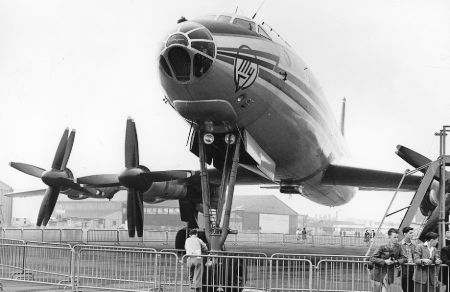Max Kingsley-Jones/LONDON

The design bureaux of the former Soviet Union have been at the forefront of giant air transport development. One of their designs, the An-225, holds the title as the world's largest aircraft. But despite ambitious plans for new giant projects, the region's economic problems mean that it will be an observer, rather than a participant, in new developments.
When the huge 171t (377,000lb) Tupolev Tu-114 turboprop (above) flew in 1957, it was by far the world's biggest production airliner of the time. It could seat up to 220 passengers and was the heaviest and largest airliner in service until the widebodies arrived in the 1960s. Lockheed'sC-5 Galaxy took the crown of largest transport in 1968, but the USSR reclaimed it in 1982 with the Antonov An-124 Ruslan, which remains the world's largest operational transport (in payload and wingspan terms). A larger, specialised one-off version was built to carry Russia's Buran space shuttle - the six-engined, tri-tailed An-225 Mriya (Dream).
Design bureaux within the former Soviet Union continue to dream of building giant transport aircraft, but the region's depressed economy has killed any early development of new large designs. The most likely scenario is that Airbus - and possibly Boeing - will call on their expertise for their new projects, with the Aviastar production plant in Ulyanovsk a leading candidate to participate in component production for the Airbus A3XX.
A few years ago, Antonov studied the development of a passenger-carrying version of the An-225, which would have seated 500-600 people on two decks. The Myasishchev design bureau has proposed a giant 500-seater featuring a wide "lifting body" fuselage based on its high-altitude M-60 surveillance aircraft.
The most exciting recent Russian giant design proposal appeared at the Sukhoi pavilion at the 1999 Paris air show, where a huge model of its proposed KR-860 twin-deck airliner was displayed. The four-engined 860-seater would have 12-abreast triple-aisle seating on the main deck, and a nine-abreast, twin aisle upper deck. Entry would be either through conventional fuselage doors or forward and aft ventral escalators.
The wing design incorporates winglets and a fold outboard of the outer engines. The design has a maximum take-off weight of 650t, 50t more than that of the An-225, while an all-cargo model would offer a 300t payload. Maximum high density seating could exceed 1,000.
Sukhoi, which usually specialises in military designs, hopes to set up an international programme to develop the giant project, but with little interest from the West, the design seems destined to remain a pipe-dream.
Source: Flight International













